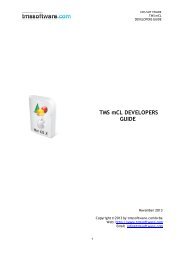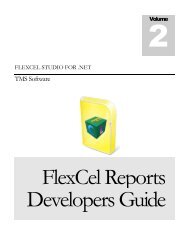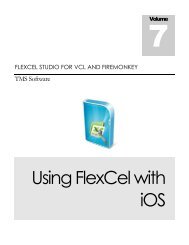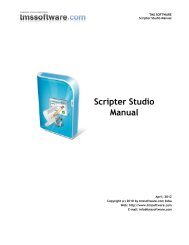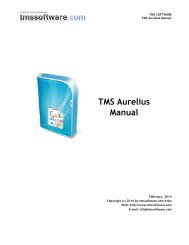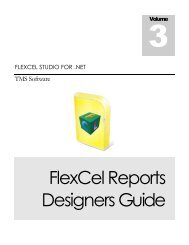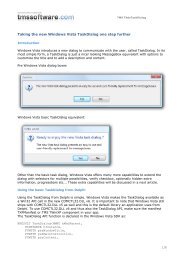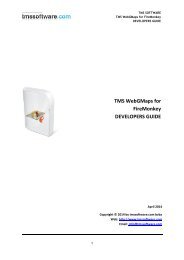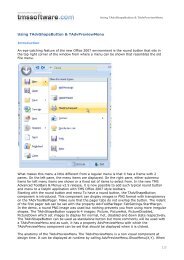Flexcel Reports Developers Guide - TMS Software
Flexcel Reports Developers Guide - TMS Software
Flexcel Reports Developers Guide - TMS Software
You also want an ePaper? Increase the reach of your titles
YUMPU automatically turns print PDFs into web optimized ePapers that Google loves.
<strong>TMS</strong> SOFTWARE<br />
FLEXCEL STUDIO FOR .NET<br />
You do not need to implement this method if the VirtualDataTable is not going to be used on<br />
Master-Detail relationships or Split relationships.<br />
FilteredRowCount: This method returns the total count of records for the current state (similar to<br />
RowCount), but, without considering Split conditions.<br />
If the dataset has 200 records, of which only 20 apply for the current master record, and you have a<br />
Split of 5 records, RowCount will return 5 and FilteredRowCount will return 20.<br />
This method is used by the Master Split table to know how much records it should have. In the last<br />
example, with a FilteredRowCount of 20 and a split every 5 records, you need 4 master records. You<br />
do not need to implement this method if you do not want to provide “Split” functionality.<br />
Setting up Relationships<br />
Once the classes have been implemented, you need to consider how to handle the relationships (if<br />
you are using your tables on master-detail relationship).<br />
If you do nothing after implementing the tables, the only way to create relationships will be on the<br />
template (via Relationship tags on the config sheet).<br />
This will be fine in most cases, but sometimes you will want to create the data model in the code,<br />
as you could with normal DataSets.<br />
The reason why you cannot user normal DataRelationships to do so is simple, DataRelationships are<br />
part of ADO.NET, they use DataColumn, DataColumns use DataTables, and so on. Since we just<br />
created brand new objects without DataTables or DataColumns, you just can't set up<br />
DataRelationships on them.<br />
To allow 'design time' relationships, VirtualDataTable offers a ChildRelations property. This is a list<br />
of “Master Table/Master Field/Detail Table/Detail Field” entries, where each entry represents a<br />
relationship within two tables.<br />
ChildRelations is protected by default, but you can expose it on your classes, or expose methods<br />
that internally will add to the ChildRelations list. Whatever relation you add to this list on the code<br />
(for example via “MyVirtualDataTable.ChildRelations.Add(MyRelation)”) will be used by<br />
FlexCelReport as if it were normal data relation.<br />
Finally<br />
When you have defined both classes, you need to create instances of your VirtualDataTable, and<br />
add them to FlexCel with FlexCelReport.AddTable. And that's all folks. For examples of how the<br />
whole process is done, please take a look at the Virtual DataSet demo, and also remember to look<br />
at the methods reference on FlexCel.chm.<br />
16 | P a g e



